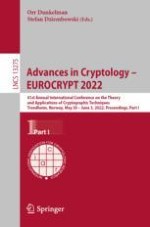2022 | OriginalPaper | Buchkapitel
Cryptanalysis of Candidate Obfuscators for Affine Determinant Programs
verfasst von : Li Yao, Yilei Chen, Yu Yu
Erschienen in: Advances in Cryptology – EUROCRYPT 2022
Aktivieren Sie unsere intelligente Suche, um passende Fachinhalte oder Patente zu finden.
Wählen Sie Textabschnitte aus um mit Künstlicher Intelligenz passenden Patente zu finden. powered by
Markieren Sie Textabschnitte, um KI-gestützt weitere passende Inhalte zu finden. powered by
